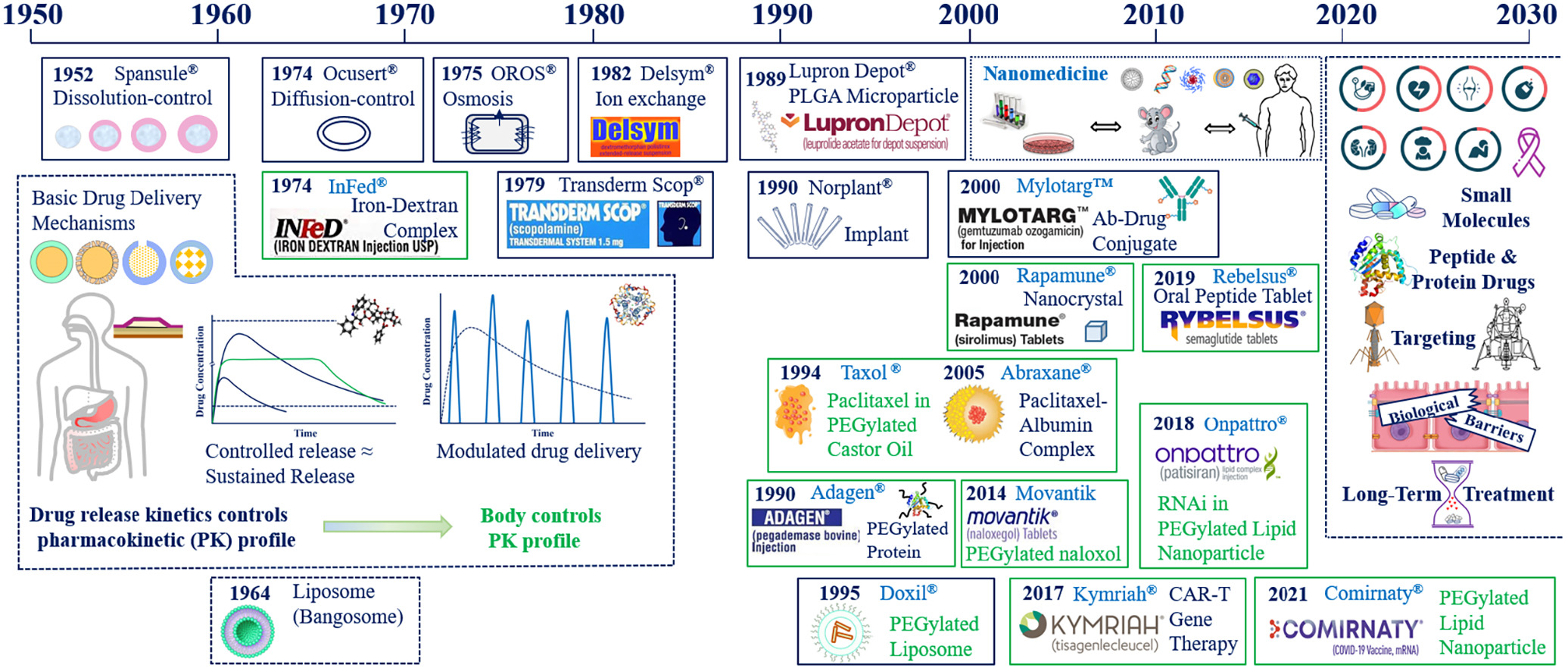Evolution of drug delivery systems: From 1950 to 2020 and beyond

Modern drug delivery technology began in 1952 with the advent of the Spansule® sustained-release capsule technology, which can deliver a drug for 12 h after oral administration through an initial immediate dose followed by the remaining released gradually. Until the 1980s, oral and transdermal formulations providing therapeutic durations up to 24 h for small molecules dominated the drug delivery field and the market. The introduction of Lupron Depot® in 1989 opened the door for long-acting injectables and implantables, extending the drug delivery duration from days to months and occasionally years.
Notably, the new technologies allowed long-term delivery of peptide and protein drugs, although limited to parenteral administration. The introduction of the first PEGylated protein, Adagen®, in 1990 marked the new era of PEGylation, resulting in Doxil® (doxorubicin in PEGylated liposome) in 1995, Movantik (PEGylated naloxone – naloxegol) in 2014, and Onpattro® (Patisiran – siRNA in PEGylated lipid nanoparticle) in 2018. Drug-polymer complexes were introduced, e.g., InFed® (iron-dextran complex injection) in 1974 and Abraxane® (paclitaxel-albumin complex) in 2005. In 2000, both Mylotarg™ (antibody-drug conjugate – gemtuzumab ozogamicin) and Rapamune® (sirolimus nanocrystal formulation) were introduced.
The year 2000 also marked the launching of the National Nanotechnology Initiative by the U.S. government, which was soon followed by the rest of the world. Extensive work on nanomedicine, particularly formulations designed to escape from endosomes after being taken by tumor cells, along with PEGylation technology, ultimately resulted in the timely development of lipid nanoparticle formulations for COVID-19 vaccine delivery in 2020.
While the advances in drug delivery technologies for the last seven decades are breathtaking, they are only the tip of an iceberg of technologies that have yet to be utilized in an approved formulation or even to be discovered. As life expectancy continues to increase, more people require long-term care for various diseases. Filling the current and future unmet needs requires innovative drug delivery technologies to overcome age-old familiar hurdles, e.g., improving water-solubility of poorly soluble drugs, overcoming biological barriers, and developing more efficient long-acting depot formulations.
The lessons learned from the past are essential assets for developing future drug delivery technologies implemented into products. As the development of COVID-19 vaccines demonstrated, meeting the unforeseen crisis of the uncertain future requires continuous cumulation of failures, knowledge, and technologies. Conscious efforts of supporting diversified research topics in the drug delivery field are urgently needed more than ever.
Haesun Park, Andrew Otte, Kinam Park,
Evolution of drug delivery systems: From 1950 to 2020 and beyond,
Journal of Controlled Release, Volume 342, 2022, Pages 53-65, ISSN 0168-3659,
https://doi.org/10.1016/j.jconrel.2021.12.030.

